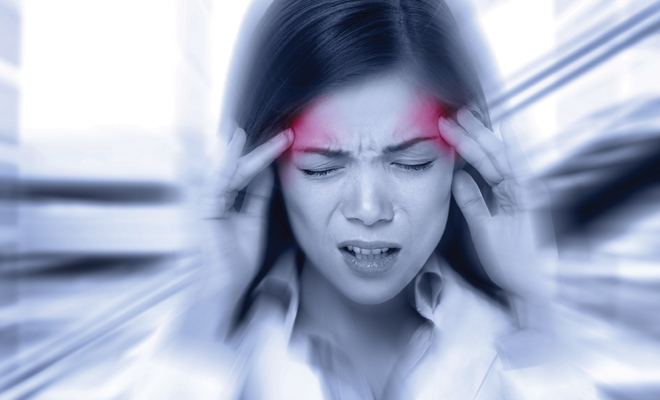
June: National Migraine and Headache Awareness Month
Rhonda is healthy, by most definitions. She eats well, exercises regularly and visits her doctor for checkups. But a few times a month, she is out of commission. She can’t get out of bed, feels an unbearable sharp pain on the left side of her head, and is nauseated or vomiting.
For most of her life, Rhonda has suffered from migraines. On her worst days, she imagines inserting an electric drill to her temple to release the excruciating pressure. The only thing that relieves the pain is to lie down in a completely silent, dark room with a hot compress to her head. She longs for the day when her migraine nightmares end.
Women and Migraines
Approximately 85 percent of chronic migraine sufferers are women. Medical experts aren’t sure why, but hormones seem to play a large part in migraines, and as a woman ages the effects vary. Female migraine symptoms can fluctuate with menstruation, hormonal contraception, pregnancy, menopause and other stressors. Symptoms can also vary for each individual.
If a woman has a family history of migraines, oral contraceptives and even a first menstrual period can trigger an attack. Migraines often worsen during the years before menopause, when intense hormonal fluctuations may occur. But the prevalence of migraines decreases significantly during menopause, when menstruation ends and hormones stop fluctuating. Migraines often improve or go away entirely after menopause.
Children and Migraines
Approximately 1 in 20 children in the United States gets migraines; these often go undiagnosed for years. Boys are affected by migraines more often than girls, but after puberty, more girls will suffer from migraines. A child who has one parent with migraine history has a 50 percent likelihood of inheriting the same thing, while a child with both parents affected has a 75 percent chance.
Hormonal Changes in Women
Fluctuations in estrogen seem to trigger headaches in many women. Women with a history of migraines often report headaches immediately before or during their periods, when they have a major drop in estrogen. Others have an increased tendency to develop migraines during pregnancy or menopause. Hormonal medications, such as oral contraceptives and hormone replacement therapy, may also worsen migraines. Some women, however, find their migraines occur less often when taking these medications.
Treatment and Specialists
Finding a successful treatment for chronic migraines can be challenging since triggers and conditions vary widely. Over-the-counter medication, prescriptions, preventative care, natural remedies and alternative medicine are just some of the treatments a primary care physician may recommend. Patients are often referred to a specialist depending on their condition.
A neurologist is specially trained in treating headaches; visiting an ophthalmologist may be advantageous if the patient exhibits eyesight issues. An otorhinolaryngologist, or ENT, can help a patient with migraines prompted by sinus symptoms. Pain management specialists and migraine clinics also treat the severe symptoms of migraines. Teeth grinding can start a headache; a dentist can provide an occlusal splint to reduce the behavior.
Botox® is approved by the FDA as a treatment for migraines. A doctor injects Botox into areas of the face and neck to block neurotransmitters that carry pain signals from the brain, stopping the chemicals before they get to nerve endings. Treatments are typically done every three to four months.
Self Help
Keeping a migraine diary can help your doctor pinpoint your personal triggers. Record when the symptoms started, how often they occur, where the pain is and the type of pain, and other descriptors. Track what you eat or if you miss a meal, weather, physical activity, sleep patterns, home and work stressors, other medications you take, even vitamins, and details of your menstrual cycle. Note if anything out of the ordinary occurred in your routine before the attack; the six to eight hours before the onset of the migraine are particularly important to record. Be attuned to what your body is telling you.
Headaches on the Horizon
As debilitating and frustrating as migraines are for sufferers, the future is full of hope and relief. Ongoing and progressive research is leading experts closer to cures. More genetic discoveries are aiding doctors and patients in their fight to prevent outbreaks, manage pain and tame the migraine beast. ■
Sources: healthline.com, mayoclinic.org, migraineresearchfoundation.org, migrainetrust.org, thedailyheadache.com and webmd.com.







